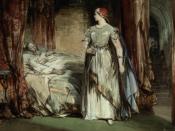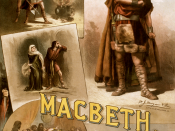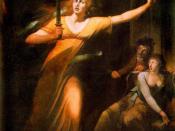The equivocal words "fair" and "foul" echo throughout "Macbeth", from the very beginning of the play, when the witches say; "Fair is foul, and foul is fair, / Hover through the fog and filthy air." Throughout the play, the contrast between fair and foul creates dramatic tension. It links the witches to Macbeth, represents Macbeth's inner moral conflict, and shows the development of Macbeth's and Lady Macbeth's characters. Thus, Shakespeare uses this conflict between foul and fair to create links between some characters, and to separate others.
Macbeth's first line is; "So foul and fair a day I have not seen." This connects his language to that of the witches, and immediately makes him appear similar to the three weird sisters. He is referring to bad weather as foul and their victory against Norway as fair, starting the long list of contrasts between foul and fair. Then the witches appear and they prophesize that Macbeth will become Thane of Cawdor and later, king.
The witches are the next aspect of the play that are both foul and fair, as they seem to be nice, by telling Macbeth the truth, however they cause Macbeth to kill Duncan in the first place. When Macbeth realises that the witches probably were telling the truth, when Ross and Angus call him the Thane of Cawdor, he wonders when he would become king, and thinks about killing Duncan to make it sooner. If the witches had not told him that he would become king, he would never have even thought about committing regicide, and it therefore represents the beginning Macbeth's confusion between good and evil. So there are two foul and fair things in the first five pages.
When Ross and Angus meet Macbeth to give him the title of the Thane...



Fair is Foul.. Foul is Fair.
Other than these `words` having to describe the "many aspects of the play", as you have written; this oxymoronic phrase implies the protagonist(Macbeth)'s inverted sense of moral and his consciousness.
Throughout the play, Macbeth becomes so morally confused, that he relies on the "apparitions" of evil, and seeks guidance and comfort throught it.
Fair is Foul.. Foul is Fair strongly suggest the instigator's flaw of confusion.
2 out of 2 people found this comment useful.